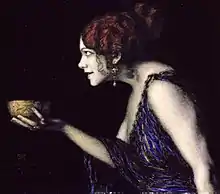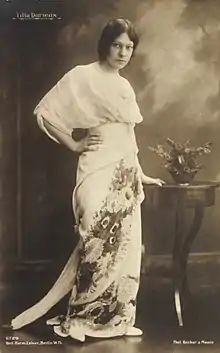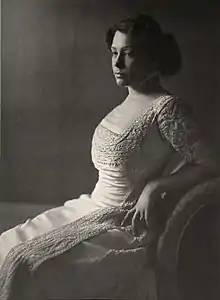Tilla Durieux
Tilla Durieux (born Ottilie Godefroy; 18 August 1880 – 21 February 1971) was an Austrian theatre and film actress of the first decades of the 20th century.


Tilla Durieux | |
|---|---|
 Photograph by Jacob Hilsdorf (1905) | |
| Born | Ottilie Godefroy 18 August 1880 |
| Died | 21 February 1971 (aged 90) |
| Occupation | Actress |
| Years active | 1902–1970 |
| Spouse(s) | Ludwig Katzenellenbogen
(m. 1930; died 1944) |
Early Years
Born Ottilie Godefroy on 18 August 1880, she was the daughter of the Austrian chemist Richard Max Victor Godefroy (1847–1895) and his wife, the Hungarian pianist Adelheid Ottilie Augustine Godeffroy (née Hrdlicka, died 1920), who was born in Romania.[1] After graduating from elementary school, she switched to the public school in Vienna's 9th district. She was baptized in the evangelical parish Augsburg Confession in Vienna.[2][3]
Career
She trained as an actress in Vienna, her native town, and made her debut at the Moravian Theatre in Olmütz (Olomouc) in 1902. Since her mother refused her career choice, she later adopted the stage name Durieux, derived from du Rieux, the maiden name of her paternal grandmother. The next season she got an engagement in Breslau (Wrocław). From 1903 she worked with Max Reinhardt at the Deutsches Theater in Berlin and with a group of expressionist artists around Kurt Hiller and Jakob van Hoddis. In 1911 Durieux entered the stage of the Lessing Theater where, on 1 November 1913, she became the second actress to perform the role Eliza Doolittle in a German language production of George Bernard Shaw's play Pygmalion, half a year before its English premiere on 11 April 1914.[4] From 1915 she performed at the Royal Schauspielhaus Berlin.
Marriages
In 1904, Durieux married the Berlin Secession painter Eugen Spiro, whose younger sister was Baladine Klossowska. They divorced consensually in 1905, after she had fallen in love with Paul Cassirer. She started dating the successful art dealer and editor and they got married in 1910. The marriage lasted 16 years, however Cassirer was very affected when Durieux wanted to divorce him. Unfortunately Cassirer had asserted various diffamations against Durieux and was obviously not willing to continue without her. When their divorce was declared in 1926, Cassiere committed suicide in a room next to the court room where their hearing had taken place (1926).[5]
Soon after, Durieux married general director Ludwig Katzenellenbogen. In 1927 they were the main financiers of Erwin Piscator's Neues Schauspielhaus project. Durieux was a public character of 1920s Berlin and associated with numerous celebrities like the photographer Frieda Riess.
Escape from Germany
In 1933, Durieux and Katzenellenbogen left Germany for Switzerland to escape Nazi rule. She continued to perform at the Vienna Theater in der Josefstadt and in Prague. In 1937 she moved to Zagreb, Croatia (then in the Kingdom of Yugoslavia) where she became a member of the International Red Aid. Durieux unsuccessfully tried to obtain visa for the United States; in 1941 Ludwig Katzenellenbogen was arrested by Gestapo agents in Thessaloniki and deported to Sachsenhausen concentration camp. He died in 1944 at Jüdisches Krankenhaus Berlin.[6]
Return and late Years
Durieux managed to return to West Germany in 1952, appearing on stages in Berlin, Hamburg and Münster. The plays in which she performed included A Dream Play by August Strindberg, The Chines Wall by Max Frisch and Atriden by Gerhart Hauptmann.
In 1971 Durieux needed surgery for a hip fracture and died of post-operative sepsis. Despite the fact that the date on her gravestone is 21. of January 1971, she died on the 21st of February 1971, which would have been the 100th birthday of Paul Cassirer.[7]
Filmography
| Year | Title | Role | Notes |
|---|---|---|---|
| 1914 | Der Flug in die Sonne | Helga Steinert | |
| 1915 | Die Launen einer Weltdame | Maud, leading role "lady of the world" | |
| 1920 | Die Verschleierte | leading role | |
| 1921 | Hashish, the Paradise of Hell | Sultanin | |
| 1921 | Der zeugende Tod | Boroka, Malerin | |
| 1922 | The Blood | screenplay by Tilla Durieux | |
| 1929 | Woman in the Moon | Fünf Gehirne und Scheckbücher | |
| 1953 | The Stronger Woman | Mutter der Fürstin | |
| 1954 | The Last Bridge | Mara | |
| 1956 | The Story of Anastasia | Zarenmutter Maria Feodorowna von Russland | |
| 1957 | Von allen geliebt | Frau Avenarius | |
| 1957 | El Hakim | Mutter des Hussni | |
| 1958 | Resurrection | Die Alte | |
| 1959 | Labyrinth | Schwester Celestine | |
| 1959 | Morgen wirst du um mich weinen | Tante Ermelin | |
| 1961 | Barbara | Armgart | |
| 1964 | Condemned to Sin | Die Großmutter | |
| 1966 | It | Die Alte aus dem Osten |
References
- Tilla Durieux: Meine ersten neunzig Jahre. Rowohlt Taschenbuch, Reinbek 1976, S. 10 ff.
- https://core.ac.uk/download/pdf/11581838.pdf
- Am 31. Mai 1928 trat sie in die katholische Kirche über, vgl. dazu: Sigrid Bauschinger, Die Cassirers, München, Beck 2015, S. 347,
- Huggett, Richard (1969). The Truth About Pygmalion. Random House.
- Durieux, Tilla (1972), Meine ersten neunzig Jahre: Erinnerungen. Die Jahre 1952-1971.(in German), Munich: Herbig, pp. 312–314, ISBN 978-3776608595
- "Ludwig Katzenellenbogen".
- Oertwig, Bernd (2019), Berühmte Tote leben ewig. Berliner Schicksale (in German), Berlin: Verlag für Berlin-Brandenburg, p. 240, ISBN 978-3947215-584
External links
 Media related to Tilla Durieux at Wikimedia Commons
Media related to Tilla Durieux at Wikimedia Commons- Tilla Durieux at IMDb
- Tilla Durieux at the Internet Broadway Database
- KGFOYVIVTilla Durieux and her Art Collection
- Portrait of Tilla Durieux painted by Renoir: Metropolitan Museum of Art
- Spielen und traeumen, a 1922 autobiographical work on Durieux's childhood at the Leo Baeck Institute, New York